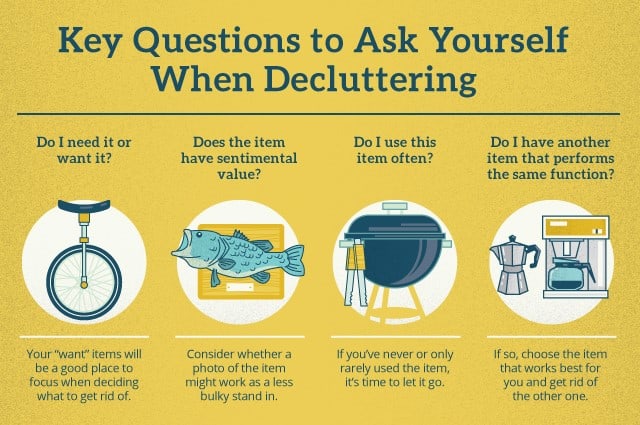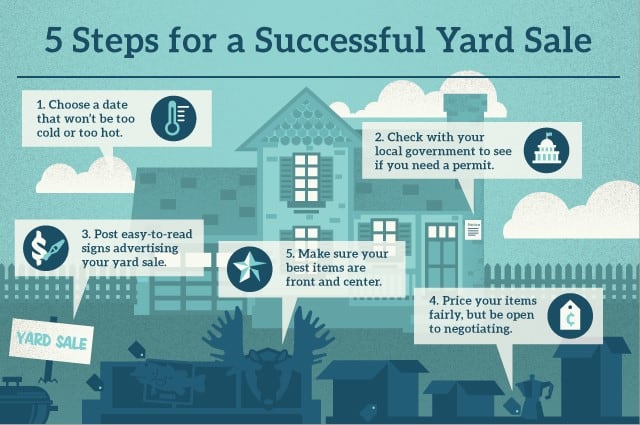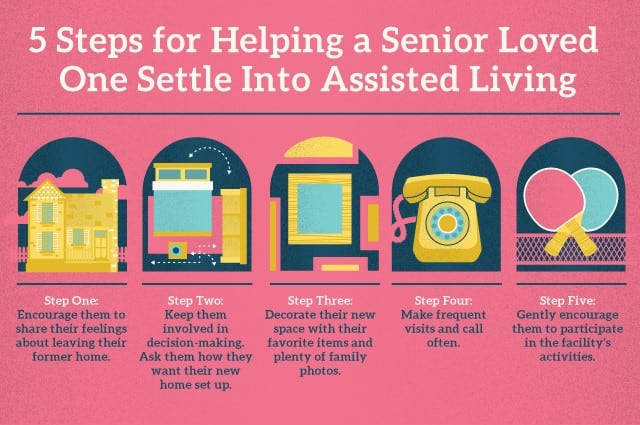A Guide to Downsizing for Seniors and Their Loved Ones

There are all kinds of benefits to downsizing in your golden years — lower energy bills, a smaller space to clean and maintain, and the potential of moving closer to loved ones are just a few. It’s a wonderful way to open the door to the next stage of your life. Even so, downsizing can be a difficult and sometimes painful experience for seniors. Saying goodbye to the home they’ve raised a family in doesn’t come easily, even if it’s the right choice from a logical standpoint.
This guide is designed to make the downsizing process as simple as possible for seniors and their loved ones. It will help prepare both house and senior for the transition, as well as offer advice to loved ones on the duties they can help perform. Keep the lines of communication open, take it one step at a time, and don’t rush into anything before you’re ready.
Step One: Determine Where the Senior is Going
It’s important to establish exactly where the senior is headed. Not only will it affect just how much they should (or must) downsize, it adds an exciting element to the process: instead of focusing on leaving their old home behind, a downsizing senior can look forward to their new home.
Of course, where the senior goes will depend on any number of factors. Mobility and ability restrictions, care-giving needs, location of loved ones, and budget will all play a role. The senior’s preferences are also crucial to the equation, and should be taken into consideration at each step. There will likely need to be compromises, especially if budget concerns are an issue, so be prepared to have multiple conversations to work out all the details. Keep in mind that the arrangements can look just about any way you want them to — many retirement communities and assisted living facilities offer personalized options to meet any need or comfort — so it’s important to make sure everyone feels comfortable with them.
There are five main options for downsizing seniors:
- Buying a smaller house or condo
- Renting a smaller home
- Moving in with a loved one (adult child, sibling, etc.)
- Moving into a retirement community
- Entering assisted living
The sooner you discuss what downsizing will actually look like, the more time everyone will have to evaluate all of the options. Don’t force the conversation if the senior seems resistant to the idea; unless your loved one has had a recent medical or care-giving issue that could hinder their quality of life, there’s no need to rush into talking about it. Bring the topic up again at a later date, potentially with additional support from family or friends. It shouldn’t feel like an intervention or anyone trying to make decisions for the senior, but a group of loved ones who genuinely want to help figure out a positive solution to their living situation.
Step Two: Declutter
It’s amazing the number of things you can acquire over the course of a lifetime. From an endless array of dishes to closets full of linens to the many mementos and knickknacks of a life well-lived, addressing these items quickly feels overwhelming for seniors and their loved ones. It’s also an incredibly emotional process for the senior involved. These aren’t just objects, they’re memories; they’re what’s made the house a home for all these years. Whether it’s you or a loved one downsizing, it’s important to acknowledge and respect this loss. Go into the process prepared to part with plenty, but giving yourself room to keep the items that mean most.
The most straightforward way to sort through items is to ask yourself four questions about the item:
- Do I need it or want it?
- Does it have sentimental value?
- Do I use it often?
- Do I have another item that performs the same function?

Do I need it or want it?
You don’t have to throw out everything you can literally live without, but you should be pretty strict about your definition of need. If you have a bread maker that’s been sitting in the cabinet untouched for years, don’t feel like you “should” keep it just because it was a Hanukkah gift. Think realistically about the years ahead: will you use it more than a few times? Are you genuinely excited for the few times you’ll use it? Will it make an important difference in your life to hold onto the item? It’s OK to say yes, but skip the guilt if the answer is no. Downsizing is about simplifying, so make a decision and feel confident in sticking to it.
Answering whether or not you want something is complicated — it’s hard to say you don’t want something you’ve had for decades, no matter what it is. Start by making a list of your absolute must-haves, the things you absolutely refuse to leave behind. It might include items like:
- Your engagement ring or wedding band
- Pocket watch
- Photo albums
- Sobriety chips
- Military badges, garments, etc.
Sit down and create a list with absolutely everything that comes to mind. Be realistic — maybe you’ll keep only a few of your favorite porcelain frogs rather than the entire 43-piece collection — but don’t worry if it seems long. Over time, reflect on each item. You don’t have to sit and agonize, just ponder the list while you’re doing the dishes, going for a walk, or running errands. Are there any items that, in retrospect, you’re ready to part with? Is there anything you’d like to give to a loved one instead? Do you know anyone who could get more use or value out of an object? Keep in mind that even if you plan to leave someone an item in the future, it can be a beautiful gift to actually watch them appreciate it in the present.
Does it have sentimental value?
The hardest items to part with will be the ones directly tied to beloved memories with your family and friends. Still, if you kept absolutely everything of sentimental value, downsizing would be impossible. Use the packing and sorting process as a way to reflect and let go. As you and a loved one go through your things, talk about them and the memories they conjure up. If you’re working solo, it can still be therapeutic to say these thoughts out loud — you can even tell your dog about the items. Just letting yourself really look back and appreciate the good times can sometimes be enough to help you let go of the mementos.
Do I use this item often?
There are going to be some items you’re simply used to having around, but ultimately don’t use very much. Think about your day-to-day routine: which items do you use the most? When you look around your house, which objects have been merely functional décor? Additionally, consider whether where you’re going will have a valuable replacement — just because you’ve always used a traditional toaster doesn’t mean you can’t adapt to your daughter’s toaster oven, for instance. Continue to be realistic about the future, keeping in mind that there might be someone else who would get much more use out of the item.
Do I have another item that performs the same function?
Whether it’s two blenders or a dozen winter coats, duplicate items are the easiest way to downsize. Choose the newest or best-functioning electronic (don’t forget to test them out to ensure everything’s in good working order), and a reasonable amount of more practical items like towels, blankets, outerwear, and other clothing. Use the opportunity to clean out your closet. Embrace the opportunity to minimize: if you really only ever wear the same three cardigans, keep those and donate the rest. Make sure you’ll have everything you’ll need, but be willing to see a smaller wardrobe. Remember: it means less laundry!
Step 3: Find new homes for the items you aren’t keeping
Moving expenses can get to be pretty pricey, especially if you hire a professional moving company or consult with a senior move manager. Yard sales are a great way to make some extra money to help fund the move, and a great way to find new homes for your things quickly.
Choose a day that’s likely to be nice, even if it’s somewhat far in the future. It might feel frustrating to wait a few months until fall, but having a yard sale in the dead of summer can be miserable in hotter regions. Plus, shoppers will be eager to get out of the sun and probably won’t have much patience. You may need to check with your neighborhood association or city zoning about having a yard sale, so find out what’s required in your area ahead of time.

Don’t underestimate the power of signage and advertisement for your yard sale — place them throughout the neighborhood, even several streets over. You never know who might be looking for bargains! Price items low and be prepared for people to negotiate. It’s more important to clear your yard of as many items as possible than to get a couple more dollars, so use your best judgment when it comes to bartering. And don’t forget to put your most valuable items in clear view so people can see all that your yard sale has to offer!
Donate any remaining items. Many charities and organizations can even pick up boxes directly from your home. It can feel impersonal and somewhat distressing sometimes — even with a yard sale, your items tend to go to neighbors you’re familiar with — but it’s important to focus on the end result. Someone in need will truly benefit from your donation and appreciate it each and every day.
Step 4: Say goodbye
Just as the senior had to say goodbye to their possessions, the time will come to say goodbye to the house, as well. It will be a difficult process, one with plenty of love and support from family and friends.
The truth is, there’s not necessarily a right or wrong way to say goodbye to the family home. It can start even before items have been packed away, as the senior walks through each room and reflects on the many memories created there. Some seniors might appreciate taking photos of all of the rooms that they can look back on while the new home feels foreign. Others may prefer to move out early instead of seeing their beloved home taken apart. Discuss what will work best for your family in an open and honest setting; don’t feel ashamed if you’re having trouble. It’s vital that the entire family supports one another throughout the downsizing process, so don’t be afraid to ask for or offer help.
However the goodbyes are said, make it a point to bid farewell. You’re closing a major, important chapter of your life. It’s OK to feel sad, even as if you’ve suffered a loss, but don’t lose sight of the exciting next step that lies ahead.
Step 5: Make the transition
No matter where the senior is headed, the new home won’t feel like home right away. Do what you can to bring in the most important items first, those that will make the senior feel especially comforted. Move-in day should be a family affair, even if you hire movers. Any member who is able to should stop by to help out, bring food and refreshments, troubleshoot issues, and simply make the occasion a happy one. Keep the mood as light and exciting as possible: focus on the fact that it’s a new beginning rather than an end.

Seniors and their loved ones should check in regularly to discuss how things are going. You don’t have to stop by every day, but a nightly call for the first week or two can certainly make a displaced senior feel less lonely. It’s especially important if they’ve just moved to an assisted living facility or nursing home, but shouldn’t be overlooked if they’ve moved in with a loved one. Just because they are with family doesn’t mean it’s been a seamless process, and there could still be underlying emotional trauma from the move itself. Find the balance between hovering and checking-in, even rotating responsibility among family members.
Give everyone time to adjust, including your spouse and children if the senior has come to live with you. It’s going to be a process for everyone to get used to the new routine, and you can’t rush the adjustment. The most important thing is to keep communication open and address issues right away. Don’t let things fall into an unhealthy or unhappy pattern; even if it’s an uncomfortable conversation initially, solving the problem is always better than turning a blind eye and hoping for the best. Remember, it’s a difficult time for all, so support is imperative.
Downsizing is often one of the best choices a senior can make, but it’s their decision in the end. Ease into the idea and keep the conversation ongoing. It will be painful, but the inevitable sting of leaving the family home should never stop a senior from simplified, happier living.
Note: All images and content in this guide are free to be published on third party websites. If doing so, please include a citation to the original article from Redfin.com


